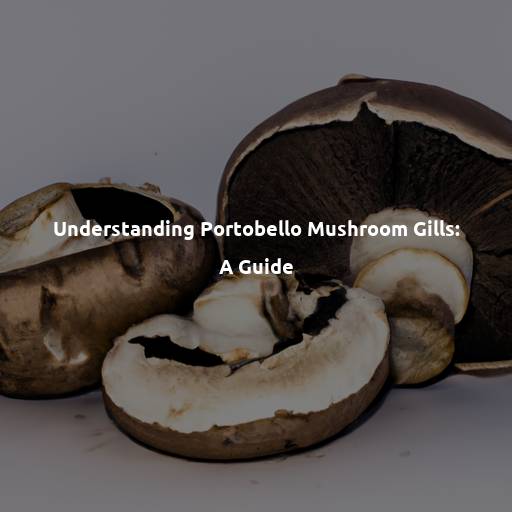Introduction to Portobello Mushrooms
Portobello mushrooms are a popular choice among mushroom enthusiasts and food lovers alike. Known for their meaty texture and rich flavor, these versatile fungi have become a staple in many culinary creations. In this guide, we will delve into the world of portobello mushrooms, exploring their unique characteristics and delving into the intricacies of their gills. Whether you’re a seasoned chef or a curious foodie, this article will provide you with a comprehensive understanding of portobello mushroom gills and how to make the most out of them in your culinary adventures. So, let’s embark on this mushroom journey together and unravel the secrets of portobello mushrooms and their fascinating gills.
What are Portobello Mushroom Gills
Portobello mushrooms are versatile and flavorful fungi that are widely enjoyed in various cuisines. One distinctive feature of these mushrooms is their gills, which play a crucial role in their growth and development. Understanding what portobello mushroom gills are and their importance can enhance your knowledge and appreciation for these delicious fungi.
Gills, also known as lamellae, refer to the thin, rib-like structures found on the underside of the mushroom cap. These gills are densely packed and run radially from the center of the cap towards the outer edge. Their unique arrangement provides an ideal surface area for spore production and dispersal.
The primary function of portobello mushroom gills is to produce and release spores. Spores are microscopic reproductive cells that, when released, have the potential to germinate and give rise to new fungal growth. By having gills, portobello mushrooms are capable of producing a large number of spores, ensuring their survival and propagation.
The gills also play a vital role in the mushroom’s growth and development. As the mushroom cap expands, the gills elongate and stretch to accommodate the increasing size. This growth pattern helps to maximize spore production while maintaining the overall structure and appearance of the mushroom.
When it comes to culinary purposes, the gills of portobello mushrooms are often included in various recipes. They have a delicate and slightly earthy flavor that adds depth and complexity to dishes. However, it’s worth noting that the gills can become dark and develop a slimy texture when exposed to moisture for prolonged periods. Therefore, it is important to properly clean and cook portobello mushroom gills to ensure the best culinary experience.
In conclusion, portobello mushroom gills are a defining characteristic of these fungi. They serve a crucial role in spore production and contribute to the growth and development of the mushroom. By understanding the function and importance of gills, you can fully harness the flavor and texture that portobello mushroom gills offer in your culinary creations.
The Function and Importance of Gills in Portobello Mushrooms
Portobello mushroom gills play a crucial role in the overall flavor and texture profile of these mushrooms. Nestled beneath the cap, the gills are thin, rib-like structures that radiate outwards from the stem. They are responsible for producing and releasing spores, which contribute to the mushroom’s reproductive process.
The gills also serve as a sponge, absorbing and retaining moisture during the growth phase. This helps the mushroom develop a tender and meaty texture when cooked. The gills absorb flavors from marinades or seasonings, enhancing the overall taste of the dish.
Furthermore, the gills contribute to the distinct aroma of the portobello mushroom. As the mushroom matures, the gills change color from white to a dark brown or black shade. This transformation not only adds visual appeal but also intensifies the mushroom’s savory fragrance.
Understanding the function and importance of portobello mushroom gills allows us to appreciate their culinary versatility. Whether you sauté, grill, stuff, or roast portobello mushrooms, the gills bring forth a depth of flavor and a unique textual experience to your dishes.
How to Identify and Examine Portobello Mushroom Gills
To identify and examine Portobello mushroom gills, begin by closely observing the underside of the mushroom cap. Portobello mushrooms have distinct gills that are located on the lower surface of the cap. These gills are thin, delicate structures that radiate from the center of the mushroom outwards.
When examining the gills, take note of their color and condition. Fresh Portobello mushroom gills should be pale to dark brown, depending on the maturity of the mushroom. Avoid mushrooms with gills that appear slimy, discolored, or have a foul odor, as these may indicate spoilage or age.
To get a better look at the gills, you can gently lift the mushroom cap and hold it horizontally. This will allow you to inspect the gills more closely. Note the spacing and arrangement of the gills. In Portobello mushrooms, the gills are usually thickly packed together.
Another characteristic to look for is the overall appearance of the gills. Healthy Portobello mushroom gills should be free from blemishes, holes, or signs of decay. Additionally, inspect the gill edges for any discoloration or damage.
Keep in mind that the gills of Portobello mushrooms are not only a visual aspect but also play a significant role in flavor and texture. The gills contain spores, which contribute to the mushroom’s unique earthy taste. Therefore, it’s important to pay attention to the quality and condition of the gills when selecting Portobello mushrooms for cooking.
By carefully examining and identifying the gills of Portobello mushrooms, you can ensure that you choose the freshest and highest-quality mushrooms for your culinary endeavors.
Tips for Cleaning and Cooking Portobello Mushroom Gills
Cleaning and Cooking Portobello Mushroom Gills:
To fully enjoy the rich flavor and unique texture of portobello mushroom gills, it’s essential to know how to clean and cook them properly. With our handy tips, you’ll be able to make the most of this delicious part of the mushroom.
Firstly, gently remove any dirt or debris from the gills using a soft brush or a damp cloth. Be careful not to damage the delicate gills while cleaning. This step ensures that your portobello mushrooms are clean and ready for cooking.
When it comes to cooking portobello mushroom gills, there are several methods you can consider. One popular option is grilling them. Preheat your grill to medium heat and brush the gills with a little olive oil to prevent sticking. Place the mushrooms gill side down and cook for about 4-5 minutes, or until the gills become tender and slightly charred.
Another alternative is sautéing the gills. Heat a skillet over medium-high heat and add a small amount of oil or butter. Place the mushrooms gill side down and cook for 3-4 minutes, or until they start to soften. Flip the mushrooms and continue to cook for an additional 2-3 minutes, or until the gills are tender.
Alternatively, you can also try stuffing the portobello mushroom caps with a delicious filling and bake them in the oven. This cooking method allows the gills to soak up the flavors of the stuffing, resulting in a mouthwatering dish.
Remember, no matter which cooking method you choose, it’s important not to overcook the gills. They should be tender and flavorful, not mushy or tasteless.
In conclusion, cleaning and cooking portobello mushroom gills can be a delightful culinary adventure. By following these simple tips, you’ll be able to savor the distinct taste and texture that these gills bring to your favorite mushroom dishes.
Common Mistakes to Avoid with Portobello Mushroom Gills
One of the most common mistakes that people make when dealing with portobello mushroom gills is completely removing them before cooking. While it may be tempting to scrape out the gills, they actually hold a lot of flavor and texture that can add depth to your dish. Instead, the gills can be gently removed or lightly scraped to reduce the black coloration, but it is best to leave some intact for a more pronounced taste. Another mistake to avoid is overcooking the gills, which can result in a slimy or mushy texture. It is important to cook them just until tender to ensure they maintain their meaty consistency. Lastly, many people forget to properly clean the gills before cooking, leading to a gritty texture. Taking the time to gently rinse or brush the gills under running water can help remove any dirt or debris and prevent this unpleasant texture in your final dish. By avoiding these common mistakes, you can fully appreciate and enjoy the unique flavors and textures that portobello mushroom gills have to offer.
Conclusion: Harnessing the Flavor and Texture of Portobello Mushroom Gills
In conclusion, understanding and harnessing the flavor and texture of portobello mushroom gills can elevate your culinary creations to new heights. By appreciating the function and importance of these gills, you can fully utilize them in your cooking endeavors. Remember to identify and examine the gills for freshness and quality, clean them properly before cooking, and avoid common mistakes such as overcooking or removing them entirely. With these tips in mind, you can unlock the rich flavors and unique textures that portobello mushroom gills bring to your dishes. Explore the world of portobello mushrooms and let their gills take center stage in your culinary adventures.

